I don't plan on only writing about a chickens, but since this was my first real farm animal for our small farm, and because backyard chickens are becoming the norm in many places, I thought blogging about chickens is a good way to start. This is part 2 of my chicken discussion, where I discuss the brooder.
 |
| Splash Marans chick, 2 days old |
A brooder is an area where you keep your new chicks. Chicks can also be hatched and raised by a broody hen, which is much easier, but the chickens tend to be a bit less friendly than those hand raised. (And broody hens are less common these days when we want our chickens to lay the eggs and leave them for us!)
The basic necessities for a brooder box are:
1) Brooder box with shavings
My first brooder box was a box - a cardboard box that I kept in the bathroom with 6 baby chicks straight from the hatchery. It stunk, was difficult to keep clean, and it seems the chicks were always knocking over their water, making a huge mess. You can raise chicks in a cardboard box, but I wouldn't recommend it.
Most places use a bin style brooder, such as a water trough. It seems to work well, but can be difficult to clean. Our last couple batches were brooded in a dog crate with a heavy blanket covering sitting up high enough to make cleaning easy. We put cling wrap around the bottom to keep from losing shavings, and developed a special formula for keeping it dry - trash bag on the bottom, followed by pellet bedding followed by a thin layer of polyester (like a sheet or, in my case, scrap quilt batting) followed by shavings. Any wetness flows through and is absorbed by the pellets, keeping the shavings dry. Chicks must stay dry - especially in the first couple weeks. A wet chick will die very quickly, so if a chick gets wet dry it well with a hair dryer until it is fluffy and warm (you can tell by the temperature of the feet).
The chicks seem to stay tiny forever, then around 3-4 weeks, they are suddenly huge. Be sure that your brooder either is big enough to accommodate growth or that you have a larger area set up for when they grow.
 |
| Polish chicks - time for a larger brooder! |
2) Heat lamp
Chicks must be kept warm. The first week 90-95 degrees, the second week 85-90 degrees, and decrease by 5 degrees until they 5-6 weeks old. You can tell if you have the right temperature if they are neither huddled together under the light (too cold) or against the wall away from the light (too hot) - they should be milling around looking for trouble.
The heat lamps can be found at most feed stores. You can use a red bulb made for the brooder, which is very warm, or use a normal 100 watt lightbulb that you will need to keep closer to the chicks. The red coloring of the bulb serves a practical purpose - when a chick is injured and has a blood spot, all the other chicks instinctively will peck at it, and may even peck the chick to death before you realize it. The red brooder light helps mask any injuries to protect the chicks.
3) Feeder and feed
I recommend a medium size feeder for the brooder - it looks enormous initially, but will be useful and big enough to use as the chicks grow. There are two types of chick feed: medicated and non-medicated. The medicated feed protects against coccidiosis, a disease which can be fatal to young chicks. Initially medicated feed sounds seems like a good idea. However, the coccidia which causes coccidiosis is present in chicken poop, and some people feel that if the chicks are given medicated feed, they don't build up an immunity to it, and are more susceptible to becoming ill when switched to regular feed. We chose non-medicated feed, and had no problems.
4) Waterer
Again, I would recommend a medium size waterer. Initially it will go right on top of the shavings so the peeps can easily reach the water, but you will need to raise it up as they grow to prevent shavings from getting in. Once the waterer is filled with shavings, not only does it prevent access to water, but the shavings pull the water out and siphon it onto the floor, causing wet chicks!
5) Additives
If your chicks are being mailed, use Save-A-Chick electolight packets (or other vitamin and probiotic powders) in the water for the first week or so to help give them a boost. We also used a "drench" to add extra vitamins the first couple weeks, and it seems to help strengthen the little ones. If your chicks are getting "pasty butt" (poop clogging the anus), you will need to keep the are clean and dry, but also add Save-A-Chick probiotics or give mix some yogurt in with their food (very messy). As they get older, buy some dried meal worm treats to teach them to come when you call.
 |
| Give me MORE mealworms! |
That's about it for today. I will soon be writing about the big girl hen house and <shudder> predators.









